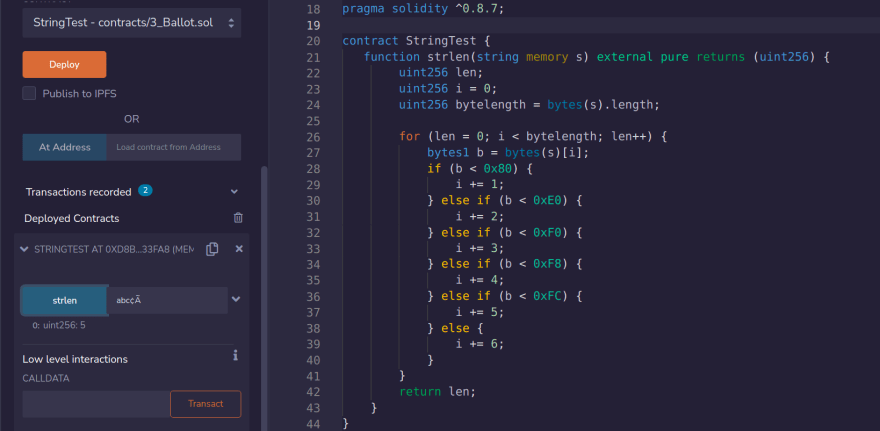Why bytes(str).length; is not enough for getting length of string in Solidity, and let’s understand the strlen method from contracts of ens
In the world of Javascript finding the length of string is such an easy thing
just do str.length and that’s all 🤌
But strings are not so friendly to work within Solidity, ❗
In solidity, the string is a group of characters stored inside an array and stores the data in bytes.
There is no length method in string type.
I was going through Buildspace’s build-polygon-ens project and found the link to StringUtils.sol,
I knew how to find length of string in Solidity we can convert the string into bytes and find length of it
So it should be as easy as doing bytes(str).length; 🤌 but the method in this util file was a bit different
// SPDX-License-Identifier: MIT
// Source:
// https://github.com/ensdomains/ens-contracts/blob/master/contracts/ethregistrar/StringUtils.sol
pragma solidity >=0.8.4;
library StringUtils {
/**
* @dev Returns the length of a given string
*
* @param s The string to measure the length of
* @return The length of the input string
*/
function strlen(string memory s) internal pure returns (uint256) {
uint256 len;
uint256 i = 0;
uint256 bytelength = bytes(s).length;
for (len = 0; i < bytelength; len++) {
bytes1 b = bytes(s)[i];
if (b < 0x80) {
i += 1;
} else if (b < 0xE0) {
i += 2;
} else if (b < 0xF0) {
i += 3;
} else if (b < 0xF8) {
i += 4;
} else if (b < 0xFC) {
i += 5;
} else {
i += 6;
}
}
return len;
}
}
It had this weird for loop in code which I couldn’t understand
So, the developer in me googled it 🕵️♀️, but all the articles I came across did this to find the length of the stringbytes(str).length; I found some similar code on Stackoverflow but no one actually explained what is happening inside.
for(len = 0; i < bytelength; len++) {
bytes1 b = bytes(s)[i];
if(b < 0x80) {
i += 1;
} else if (b < 0xE0) {
i += 2;
} else if (b < 0xF0) {
i += 3;
} else if (b < 0xF8) {
i += 4;
} else if (b < 0xFC) {
i += 5;
} else {
i += 6;
}
}
After 3 hours of 🐌 self-exploration I was able to figure it out myself (a little slow but I did it 🍾),
So I thought let’s write it down so it would be helpful for all the folks like me (not so experienced with bits, bytes 0️⃣1️⃣).
So now, let’s try to Unblock/ Decode this
How bytes(str).length works
when we convert string to bytes this is what Solidity does
// if we do bytes("xyz"), solidity converts it as
xyz -> 78 79 7a // 78=x, 79=y, 7a=z
ABC -> 41 42 43 // 41=A, 42=B, 43=C
Use this website for converting strings to bytes
If you see each character generates 1 byte
that’s why when we do bytes(””).length we get the length of string,
But there are some characters for which generated bytes are more than one
For example
€ -> e2 82 ac
For the symbol of the Euro, generated bytes are 3
So if we try to find the length of string which includes the symbol of Euro(€) 🤑 in it, the length returned by
bytes(str).length, will not return the correct string length for this character as € there are 3 bytes generated
that’s when that for loop we've seen above comes to the rescue ⛑️
Let’s iterate over this e2 82 ac bytes array and check what’s happening inside that loop
for(len = 0; i < bytelength; len++) {
bytes1 b = bytes(s)[i];
// b = e2 for first iteration
if(b < 0x80) {
i += 1;
} else if (b < 0xE0) {
i += 2;
} else if (b < 0xF0) {
i += 3;
} else if (b < 0xF8) {
i += 4;
} else if (b < 0xFC) {
i += 5;
} else {
i += 6;
}
}
for the first iteration b=e2
there is a condition on the following line
if(b < 0x80) {
i += 1;
}
let's decode this, this condition will basically compare decimal values of these hexadecimal characters
Decimal value for
0x80 -> 128
// our b is e2 at the moment, decimal value for e2 = 226
0xe2 -> 226
for regular characters, decimal conversion of their hex character will be < 128 , like for a it is 97
So, if we check all conditions like this
for(len = 0; i < bytelength; len++) {
bytes1 b = bytes(s)[i];
if(b < 0x80) { //0x80 = 128 => 226 < 128 ❌
i += 1;
} else if (b < 0xE0) { //0xE0 = 224 => 226 < 224 ❌
i += 2;
} else if (b < 0xF0) { //0xF0 = 240 => 226 < 240 ✅
i += 3;
}
...
}
So, now our i is 3,
so the condition in for loop will be 3<3, which is false and the loop will break, and the value of
len will be 1 at the moment
And that’s it, it is the correct value for the length of string “€”
If you want to try some more strings like “€”, here is a small list of characters that occupies more then 1 byte
€ -> e2 82 ac
à -> c3 83
¢ -> c2 a2
Create, a random string anything like abc¢Ã, this for example, and try it out
Ta-Da 🎉, and now it works
Connect with me on Twitter: @pateldeep_eth
DMs are open to any kind of improvement suggestions
Originally published at https://pateldeep.xyz/





Top comments (0)